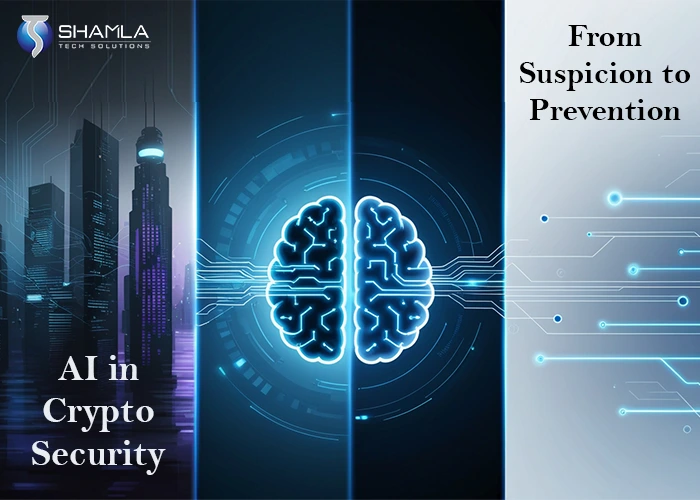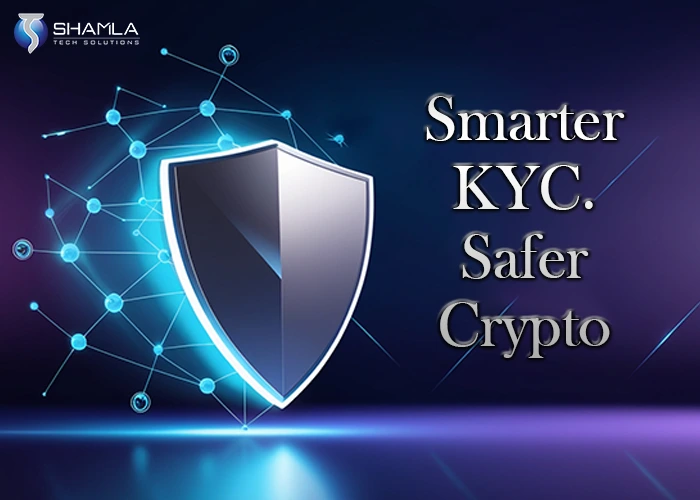Artificial intelligence (AI) and blockchain technology convergence is changing the banking and financial services sector. AI and blockchain are propelling innovation at an unmatched speed, from automating operations to improving security and personalizing consumer experiences. The blog discusses the changing use cases of artificial intelligence in banking, how AI secures crypto transactions through its integration with blockchain, and the prospects and difficulties that lie ahead.

AI-Enhanced Blockchain Security and Fraud Detection
Artificial intelligence strengthens even more blockchain’s natural security, thereby allowing you to create your own AI crypto coin. Artificial intelligence systems can spot irregularities in blockchain transactions, and AI secures crypto transactions, flags fraudulent operations, and blocks cyberattacks. AI, for example, can track transaction trends to highlight questionable conduct, such as money laundering or illegal access. This mix of artificial intelligence and blockchain guarantees a strong security framework for financial systems.
Lending and Credit Management Using AI & Blockchain
By automating loan approvals and enhancing risk assessment, artificial intelligence is changing lending and credit management. AI algorithms evaluate borrower credibility by means of credit ratings, transaction histories, and alternative data sources, including social media activity. By guaranteeing openness and unchangeability of loan contracts, blockchain helps to lower conflicts and build confidence between lenders and borrowers.
Artificial Intelligence in the Fraud World
With its machine learning algorithms to examine massive datasets in seconds, artificial intelligence profoundly transformed the scene of the internet and fraud world by seeing trends and aberrant behaviors suggesting fraudulent activity. Unlike conventional legacy systems, artificial intelligence models may learn from the new data they acquire from all over, including text, voice, photos, and videos. In this manner, they are changing to combat fraud strategies in real-time. AI’s ongoing learning capacity helps companies to keep one step ahead of men, hence lowering false positives and enhancing detection accuracy.
For instance, let us examine the finance industry. AI secures crypto transactions thereby here tracks transaction patterns, and flags odd ones; by evaluating variables including transaction amounts, transaction frequency, locations, and even transaction times, AI systems can find possible fraud that could occur at any time, so protecting companies and users
Face Recognition
One of the artificial intelligence technologies that has been around for some time is facial recognition. This biometric identification system verifies a person’s identity by means of analysis of individual facial characteristics, hence protecting it from identity theft and illegal access to accounts.
How Facial Recognition Reduces Fraud?
- Face recognition confirms accounts; hence, only real people log in or establish accounts.
- AI secures crypto transactions, and high-value transactions could call for facial recognition to protect from illegal access.
- Advanced algorithms identify fraud attempts utilizing photographs, videos, or deepfake technologies.
- For businesses to utilize facial recognition to verify that the user registering or logging in is real is among the best decisions. Facial recognition guarantees high transactions, financial services, e-commerce, and online banking as well.
AI-Enhanced KYC (Know Your Customer)
AI secures crypto transactions and simplifies KYC procedures.
Biometric Authentication
Facial recognition, fingerprint scanning, and liveness detection guarantee users are physically present during verification, hence combating deepfakes.
Document Verification
Using pixel-level analysis, AI cross-references official IDs with worldwide databases to find fraudulent documents.
Behavioral Analytics
Ongoing monitoring alerts accounts with abrupt activity changes, such as a dormant wallet starting high-frequency trades.
Arya AI’s KYC tools cut synthetic identity fraud by 60% and lowered onboarding times by 70%.
AI in AML (Anti-Money Laundering)
By breaking up money laundering systems, AI secures crypto transactions.
Transaction Pattern Analysis
Graph-based algorithms find layering approaches by mapping links between wallets, exchanges, and off-ramps.
For instance, artificial intelligence finds a cluster of wallets sending money to a sanctioned organization via a mixer, therefore triggering an inquiry.
Risk Scoring
Factors like quantity, location, and counterparty history determine the risk score for every transaction. AI secures crypto transactions and high-risk transactions are subject to more investigation.
Regulatory Reporting
AI guarantees FATF Travel Rule and MiCA regulation compliance by automating suspicious activity reports (SARs).
Outcome: Institutions implementing AI-driven AML solutions have cut illegal transaction volumes by 35%.
How to integrate AI in blockchain?
Here we break down the process of integrating AI in blockchain and it can also help you build your own AI crypto coin.
Step 1: Define the Purpose of AI Integration
Companies have to first decide the exact goal artificial intelligence will serve before incorporating it into the blockchain. AI can increase scalability, examine blockchain data, AI secures transactions, or strengthen security. For instance, methods of fraud detection driven by artificial intelligence in Bitcoin exchanges help to stop questionable actions. A MarketsandMarkets study indicates that from $220.5 million in 2020 to $973.6 million by 2027, artificial intelligence in blockchain is projected to demonstrate growing popularity.
Step 2: Choose the Right Blockchain Platform
For artificial intelligence integration and also AI secures crypto transactions, choosing the correct blockchain platform is absolutely vital. Among the well-known blockchain systems enabling artificial intelligence programs are
- Ethereum: Decentralized apps (DApps) and smart contract features.
- Hyperledger Fabric: Enterprise-appropriate permissioned blockchain.
Step 3: Leverage AI for Data Analysis and Predictive Modeling
Blockchain has a lot of data that AI can analyze. AI models improve decision-making, trend prediction, and pattern recognition. Artificial intelligence-driven blockchain analytics solutions like Chainalysis monitor unlawful transactions and fight money laundering using machine learning. Crypto traders can also make smart investments with predictive analytics.
Step 4: Automate Smart Contracts with AI
Though they may call for predetermined criteria, smart contracts run transactions on the blockchain. AI can improve smart contracts by making them self-learning and adaptive. An AI-powered smart contract in insurance, for instance, may evaluate real-time risk variables and change policy conditions accordingly. This maximizes contract execution efficiency and reduces human involvement.
Step 5: AI-Based Threat Detection Can Improve Security
Blockchain networks raise significant security issues. By means of real-time cyber threat detection and vulnerability identification, artificial intelligence can improve security. AI-driven security systems like DeepBrain Chain guard against assaults on blockchain networks. By means of machine learning algorithms that examine network activity and identify irregularities, dangers such as double-spending and Sybil attacks are mitigated.
Step 6: Optimize Energy Consumption in Blockchain Networks
Significant energy is consumed by blockchain processes, particularly those of Proof-of-Work (PoW) systems such as Bitcoin. By forecasting network loads and changing computational power, artificial intelligence can maximize energy use. For example, artificial intelligence-powered solutions can assign energy-efficient mining operations, hence lowering total carbon footprints. A Cambridge University study discovered that Bitcoin mining uses more energy than Argentina; hence, AI-driven improvements are very important.
Step 7: Use AI-Blockchain Synergy for Decentralized AI Marketplaces
Decentralized artificial intelligence markets let developers safely distribute AI models free of intermediaries. While artificial intelligence improves accessibility, blockchain guarantees openness. Platforms such as Fetch.ai enable AI systems to trade services autonomously by using blockchain to power distributed machine learning applications. This mix encourages creativity and makes artificial intelligence more widely available.
Step 8: Ensure Data Privacy and Compliance
While managing sensitive data on a blockchain calls privacy, artificial intelligence needs huge datasets for training. Blockchain can be combined with privacy-preserving artificial intelligence methods such as federated learning and homomorphic encryption to guarantee safe data processing. Ocean Protocol, for instance, lets data owners share AI models while preserving user privacy by not disclosing raw data.
Step 9: Implement AI-Powered Identity Verification
Especially in banking and healthcare, blockchain transactions need identity verification so AI secures crypto transactions. By means of facial recognition, voice patterns, and fingerprints, AI-driven biometric authentication can improve Know Your Customer (KYC) procedures. Reducing fraud concerns, companies like Civic provide safe digital identity solutions built on blockchain and artificial intelligence.
Step 10: Monitor and Improve AI-Blockchain Integration Continuously
Continuous monitoring is needed to improve AI-blockchain performance following implementation. AI can secures crypto transactions and help speed up transactions and optimize blockchain consensus systems. AI-driven innovations, audits, and regular updates help to guarantee the system stays safe and effective.

The Role of AI in Secures Crypto Transactions
By using sophisticated algorithms to identify fraud, streamline procedures, and improve identity verification, AI secures crypto transactions. What Is an AI Agent in Crypto and How Does It Work? If you learn this, you can also incorporate the same thing in to your crypto exchange development process and develop the best AI based crypto coin. Important ways artificial intelligence is changing security in the crypto field are listed below:
1. Fraud Detection
Because of their distributed and pseudonymous character, bitcoin transactions raise major fraud concerns. Real-time analysis of vast amounts of transaction data by artificial intelligence algorithms helps to find abnormalities, including peculiar trade patterns, unexpected increases in transaction volume, or questionable wallet behavior. By guaranteeing proactive detection and prevention, machine learning models constantly change to new fraud methods.
2. Enhanced KYC Processes
To stop money laundering and satisfy regulatory requirements, cryptocurrency exchanges must follow Know Your Customer (KYC) rules closely. By cross-checking user data against worldwide databases, confirming government-issued IDs, and applying biometric authentication such as face recognition or fingerprint scanning, AI-powered KYC solutions simplify identity verification. These systems also identify synthetic identities produced using generative artificial intelligence deepfakes.
3. Transparency of Blockchain
By examining transaction records for unusual activity, artificial intelligence increases blockchain transparency. A graph-based study distinguishes sophisticated laundering efforts from normal trading. AI guarantees a safe environment for monitoring money and spotting illegal operations by means of blockchain’s unchangeable character.
4. Real-Time Risk Profiling
AI analyzes historical data, market trends, and geopolitical events to predict dangers. Predictive analytics assists exchanges in preventing threat growth.
How does AI in blockchain improve security?
Integrating Machine Learning Algorithms
The use of machine learning algorithms is one of the main ways artificial intelligence strengthens blockchain security. These algorithms can examine large volumes of blockchain transaction data to find patterns and behaviors suggesting harmful activities. For instance, artificial intelligence (AI) systems can identify transactions that differ from usual patterns or fit recognized fraud signatures, hence greatly lowering the possibility of fraudulent operations. Reporting in 2020 indicated that AI-based systems identified over 70% of all fraudulent transactions in blockchain settings so AI secures crypto transactions.
Improving Consensus mechanism
By means of enhancing consensus mechanisms—which are essential for validating transactions on the blockchain—AI also enhances blockchain security. Assaults, like 51% of assaults, can target conventional consensus methods, such as Proof of Work (PoW) and Proof of Stake (PoS). By monitoring and forecasting network activity, artificial intelligence can identify indications of possible attack attempts, hence strengthening the general resilience of these consensus protocols. Moreover, artificial intelligence can assist in precisely allocating resources among blockchain nodes, hence improving the speed and dependability of transaction verification and so strengthening security by lowering the probability of successful cyberattacks.
Improving Cryptographic Methods
The application of artificial intelligence in improving cryptography techniques is another major development. Compared to conventional cryptographic procedures, artificial intelligence models can generate more sophisticated encryption methods more difficult to break. AI-driven innovations that continuously evolve in response to new attack vectors can help blockchain’s dependence on public-key cryptography for providing secure transactions. Machine learning can also be used to find weaknesses in cryptographic algorithms, therefore enabling rapid patching before these weaknesses could be used by attackers. Constant development of blockchain technology helps to safeguard its data from being compromised by more and more advanced hacking methods.
Prevent Double-spending
AI secures crypto transactions and it is also quite helpful in enhancing the identification and prevention of double-spending, a possible weakness in blockchain transactions. The possibilities of a double-spend incident are greatly lowered by constantly scanning the network and using artificial intelligence models to monitor assets and AI secures crypto transactions in real-time. AI-driven real-time monitoring enables instant detection of unusual behavior and helps to stop fraudulent efforts, hence preserving the integrity of the blockchain ledger.
Access management systems
AI-driven identification and access control systems provide another dimension of security improvement. Blockchain applications can utilize artificial intelligence to validate identities by means of biometric recognition or behavioral analysis. AI can evaluate patterns like keystroke dynamics, speech recognition, and other unique identifiers to guarantee that only authorized users may access or change blockchain data. Such security policies greatly lower the chances of insider threats, data breaches, and illegal access.
Improve overall network resilience
Predictive analytics helps to increase general network resilience by means of artificial intelligence in blockchain. AI secures crypto transactions by means of algorithms that forecast possible bottlenecks, downtimes, or threats by means of past performance and behavior studies of blockchain networks. Anticipating these problems helps artificial intelligence to set off preventive actions like rerouting traffic, improving node verification procedures, or applying transient patches before any attack or failure takes place.
Conclusion
AI secures crypto transactions, improving exchange platforms, allowing the development of creative tokens, and adding autonomous agents, changing blockchain interactions. Artificial intelligence is transforming the cryptocurrency sector. Whether you’re developing your own AI crypto coin or investigating how AI secures crypto transactions via fraud detection or KYC compliance, one thing is certain—AI secures crypto transactions and safeguards finance’s future.
Using these developments wisely will help us to build a more open, efficient, and safe environment for every participant in the crypto sector. We at Shamlatech help you to integrate AI in blockchain and enable the best AI-powered crypto exchange development


